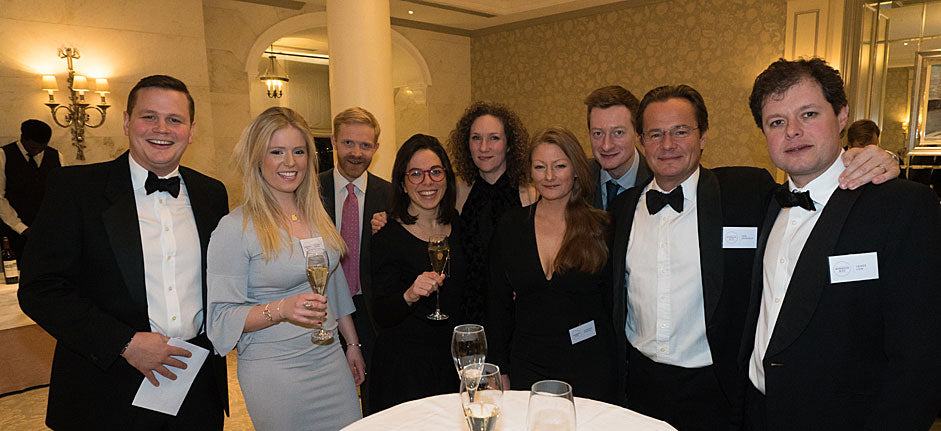
Last week’s 2005 extravaganza was quite a contrast to my previous experience of The Wine Dinner, where we had poured the mature 1990s in 2016. I had fostered some private fears that the tasting might be a difficult one. I had worried that, despite their fabled quality, the wines would be too young (still!) to assess, the concentration too intense, the profiles potentially dumb and closed. But I was completely wrong. I found, to my surprise and delight, the wines generally open and easy to taste. There is certainly noticeable concentration, but these are not heavy bodied, blockbuster wines. Their weight is medium and agile, and their tannins are exquisitely fine and well-integrated with the sweet tones of fruit. All elements are in superb equilibrium. It was a thrilling moment to taste across the region, and fills me with great hopes for re-tasting the wines in the future, as they clearly have long lives ahead of them.
I had fostered some private fears that the tasting might be a difficult one. I had worried that, despite their fabled quality, the wines would be too young (still!) to assess, the concentration too intense, the profiles potentially dumb and closed. But I was completely wrong. I found, to my surprise and delight, the wines generally open and easy to taste. There is certainly noticeable concentration, but these are not heavy bodied, blockbuster wines. Their weight is medium and agile, and their tannins are exquisitely fine and well-integrated with the sweet tones of fruit. All elements are in superb equilibrium. It was a thrilling moment to taste across the region, and fills me with great hopes for re-tasting the wines in the future, as they clearly have long lives ahead of them.
Some of the 2005s were just beginning to show tertiary flavours, but on the whole, despite their 13 years of maturation, the majority were impressively youthful. As David explains here, 2005 has enjoyed wide critical acclaim, and although rivalled by 2010, still holds supreme in many experts’ opinions. So it was no surprise that the wines were of exceptionally high quality. Any that disappointed did so only in comparison to their peers on the night. In isolation my reading of them may have been more generous. This is what makes The Wine Dinner such a unique opportunity for the taster. Working in this industry, we do have the chance to taste some of the world’s greatest wines, but these moments often occur in isolation. Outside of the en primeur tastings, it is a rare chance that we taste all the top wines from the same vintage side by side. So on Thursday night the weaker wines were probably unfairly criticised given the competition, for the successes were truly magnificent. Tasting a flight of First Growths of decade+ old claret is a rare treat.
All the wines were decanted in the afternoon before the tasting at The Savoy on Thursday 22nd March.
Click here to read David’s notes on Pomerol, Margaux, and Pauillac.
Below are my notes on Pessac Léognan, St Emilion, St Julien, and St Estèphe.
 Pessac-Léognan
Pessac-Léognan
Domaine de Chevalier Cru Classé Pessac-Léognan
Some soft Merlot character mollifies the cool, fresh Cabernet fruit flavours. The medium-weight body is laced with supple tannins and firm freshness, quintessentially Pessac in style. Berry freshness, savoury bite, and a long, silky finish. The first wine of the tasting, and a delightful way to start.
Ch Haut Bailly Cru Classé Pessac-Léognan
In contrast to the Domaine de Chevalier, which feels supple and open and almost ready to drink, this Haut Bailly is still a tightly wound fist. Dark fruit and smoky oak aromas are followed by a densely tannic, savoury structure. The tannic content is extremely fine, but still dominates the palate, suggesting it needs at least another 5 years in the cellar before its starts to unfurl. The quality of integration between acidity and fruit, weight and length, is utterly brilliant, and when this wine is ready to drink, it will be a beauty.
Ch La Mission Haut Brion Grand Cru Classé Pessac-Léognan
What tender, sweet, berry-scented fruit on the nose! This is a bewitching 2005, with beautifully fine, powdery tannins and a lithe body. Effortless, and absolutely delicious.
Ch Haut Brion 1er Grand Cru Classé Pessac-Léognan
Undoubtedly one of the greatest wines of the night (it was a toss-up between Haut Brion, Margaux, and Lafite). This was utterly sensational. Intoxicating, smoky, fluent, svelte. Absolutely flawless.
St Emilion
Ch Canon 1er Grand Cru Classé St Emilion
Sweet spiced plums and red berries on the nose. The body is effortlessly smooth, with graceful tannins dancing through to a long, fine finish. One of my favourite St Emilions of the night.
Ch Figeac 1er Grand Cru Classé St Emilion
This stood in contrast to most right bank wines, showing the high level of Cabernet fruit in its bend. It also showed much more evident evolution than most others, with aromas of leather and sous bois. The smooth palate’s resolved tannins interwove with the dusty fruit. It had a refreshing balance but lacked the drive and punch of some other examples.
Ch Angélus 1er Grand Cru Classé St Emilion
I found this a little dumber on the nose than many others, but my interpretation stands at odds with David’s, who scored this highly. The palate has a dark, brambly character with chewy tannins. The finish is long, but lacks a little of the refinement and elegance I found in the others.
Ch Cheval Blanc 1er Grand Cru Classé St Emilion
Sweet plummy fruit shows terrific finesse from this regal right bank estate. The palate was long, nervous, and full of complex flavours that will unfold over the coming years. Extremely impressive.
 St Julien
St Julien
Ch Léoville Poyferré 2ème Cru St Julien
This was hugely enjoyable. With the delectable aroma of cool Cabernet fruit on the nose, the palate flowed with lingering fruit and silky tannins. Brambles, damson, nutmeg spice; an aromatic style of great charm.
Ch Léoville Barton 2ème Cru St Julien
A stark contrast to the dancing Poyferré, this was inky, deep, smoky, graphite-scented and tannic. The tannins are well-structured, and although bold, not overpowering. Thus the wine has a muscular gait without toppling over. It should go on evolving for many years to come.
Ch Léoville Las Cases 2ème Cru St Julien
The most closed of the three Léovilles. This comes as little surprise; Las Cases is known for needing many years to come around. The good news is, if you have any in your cellar, that it will, and when it does, it should sing. The cranberry fruit with a bramble swirl sits tightly on the palate at the moment. It has a beautiful freshness running down its seams, but for now, the tannins and fruit are still too tightly wound to offer much pleasure. Save for later.
Ch Ducru Beaucaillou 2ème Cru St Julien
This had a brilliant ruby lustre, still so youthful in appearance. Its aromas suggest a thick-skinned concentration to the fruit of 2005. The palate has a sinewy, brawny strength with tremendous depth to its deeply fruited cassis character, showing exceptional minerality.

St Estèphe
Ch Lafon Rochet 4ème Cru St Estèphe
This wine occupied a difficult position in the flight, falling after the superb Pichons. But it held its own with grace and charm. The wine showed some tertiary development of savoury fruit, leather and spice. The tannins had a chewy grip, maybe less satin-like than some others, but nonetheless very appealing. It is an open and engaging style, not overly complex, but very enjoyable.
Ch Montrose 2ème Cru St Estèphe
I’m afraid this was a disappointment. It showed a vegetal edge, and had a mean structure that lacked the bounce of the other wines. Several bottles tasted, and all underwhelmed in comparison with its peers.
Ch Cos d’Estournel 2ème Cru St Estèphe
Better than the Montrose, but still not a shining example. It shared some of Montrose’s vegetal edge, but had a more supple density to its fruit. In its defence it did show off St Estèphe’s chalky freshness well.


